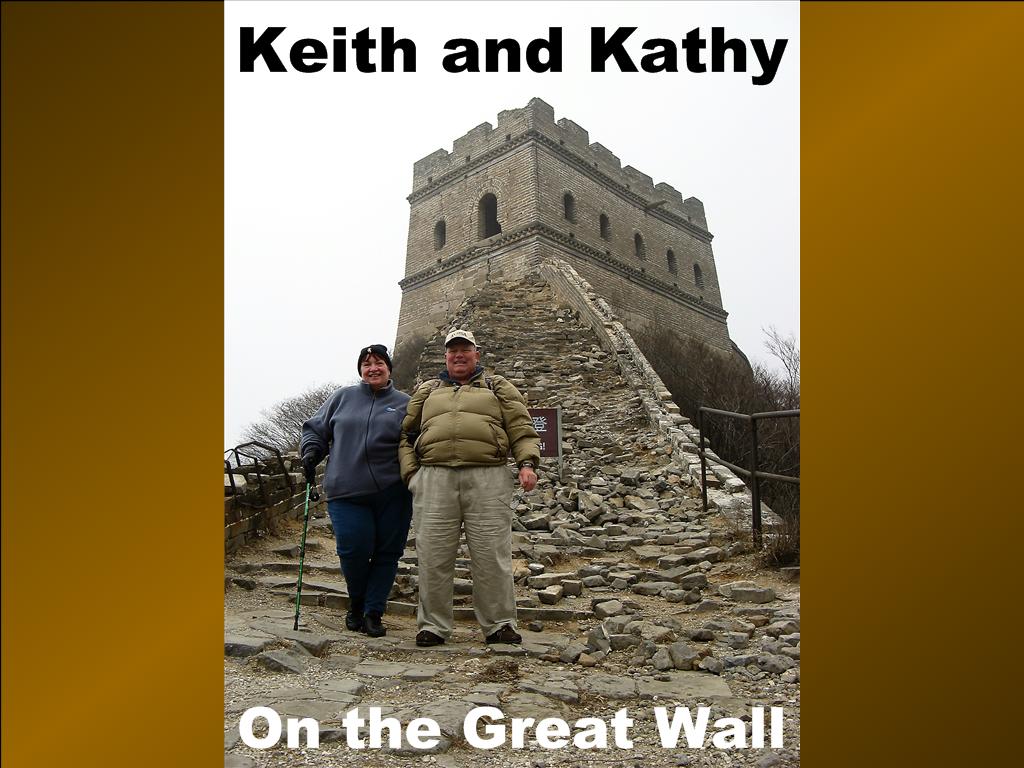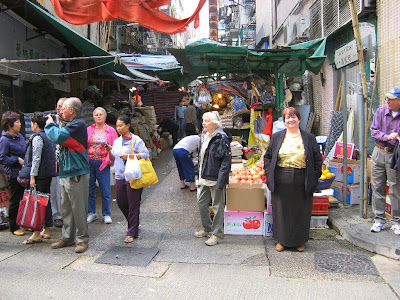
Introduction
What follows are our impressions of China.
The Chinese People
The essence of China is, of course, the Chinese people. They are anything but inscrutable, being open and friendly and anxious to be helpful. Even the street vendors (and there are thousands of them) try to be good natured in pressing their very assertive marketing initiatives. But the most notable thing about the Chinese people is, there are so many of them; well over a billion, in fact. More than four times the population of the United States. Four hundred million people, more than the US population, live in the lower Yangtze river valley, which has a land area roughly equal to Massachusetts. In China, city is a place with more than 500,000 people. The population of the largest Chinese city, Chengdu, is 30 million. A town has between 500,000 and 50,000 people. Any population center with less than 50,000 people is just a village.

But these are only numbers. What really brings home the Chinese population density is the heavy crowds; in the streets; in the train stations; in the markets; everywhere! Negotiating these milling, jostling, shoving crowds is what makes the Chinese population density seem real.
The Hutong
Iin Beijing, we toured the Hutong district. These old residential neighborhoods consist of acres of low, flat roofed buildings crisscrossed by narrow lanes. An family of three or more generations may live in a single room. Cooking is done over a coal fire in an exterior courtyard. There is no indoor plumbing. A community toilet and a public shower serve these needs. Small vendor booths and storefronts line the major alleyways. These are not slums; they are traditional Chinese residential areas, with respectable, hardworking residents. They are gradually being replaced with modern high rise condominiums in the city, and with larger modern houses in the villages.

Westernization
The Chinese are obsessed with westernization. Many Chinese people adopt an anglicized given name, usually in their early teens. The urban Chinese dress also reflects western tastes, especially the young ladies, who wear designer pants, high healed leather boots, tailored jackets, etc. Only in the rural areas is the "traditional" Chinese peasant garb seen.
Another facet of westernization is bilingual signage, not only in the port cities, but in the interior as well. The second language is always English, which appears to be gaining ground as the international language of business.
Yet another manifestation of westernization is urban traffic congestion and pollution. Smog is endemic, in part because so much coal is burned, for cooking, and for electric power generation. Chinese traffic is chaotic. Cars, busses, bicycles, and pedestrians all mill together in the roadway. Chinese drivers dart in and out, expecting others to yield. We called it “toot and go”. It seems very dangerous to be a pedestrian in urban China.
Industrialization
Industrialization is a major element of the Chinese obsession with westernization. When we landed in Shanghai, we thought the pilot had lost his way and taken us to Cleveland. The Chinese industrialization appears to be based in substantial part on the joint venture approach. In this paradigm, a foreign company sets up a factory staffed with Chinese workers, and teaches them how to make a product; Buicks, for example. In addition to generating goods, foreign exchange, and profit, the Chinese workers and managers learn the technology of the product and the manufacturing process.

We asked ourselves how the Chinese have achieved so much progress in so sort a time, since the Cultural Revolution. Based on over 20 centuries of empire, the Chinese mindset seems well adapted to the authoritarian paradigm. This makes it relative easy for the government to motivate people to all march in the same direction, in pursuit of a stated goal. During the Cultural Revolution, the stated goals were destructive. In more recent times, this "national force" has been harnessed more positively, in pursuit of modernization, westernization, industrialization, and profit. The Chinese Communist Leader Deng Xiaoping set the tone after the Cultural Revolution, with his famous pronouncement that “Profit is Glorious”. If you think about it, that is quite a statement from a communist leader!
Contrasted with the almost frenetic drive into the 21st century, much remains unchanged in China. While the Chinese government drives relentlessly to send men to the moon, there are one hundred thousand bang-bang boys in Chongqing who will carry heavy loads of groceries up 10 flights of steps for a quarter. (High rise residences in China are not required to have an elevator if less than 10 stories tall.) While hundreds of modern joint venture factories spew tons of goods across the ocean, almost a billion farmers continue to till the soil behind a water buffalo. There appears to be little initiative to mechanize farming. We speculate that the government may be concerned about what to do with the billion idle hands that would be created if the Chinese soil were tilled with gigantic farm machines like those seen in Iowa. All the above notwithstanding, China now has enough food for everyone. Food rationing ended about 10 years ago.

Rapid industrialization has created problems with air and water quality, and the greed which accompanies the pursuit of profit has created problems with the quality of construction in new public works. The Three Gorges dam is magnificent, but the water is polluted and the concrete is cracking. The Chinese use the term "tofu construction" to designate projects that are seriously deficient as a result of management corruption. The Chinese president Hu Jintao recently stated pollution and corruption as two of his greatest challenges, and has declared zero tolerance for corruption.

But then, we recently lost a bridge in Minneapolis, so we can't be too critical.
Tourist Destinations - History, Scenery, and Pandas
There are many historical and natural wonders to see in China. While much was destroyed in the Cultural Revolution, some cultural treasures were preserved, and many have been rebuilt. Among the most imposing are the Great Wall, the Forbidden City, the Terra Cotta Warriors, the Three Gorges and the Three Gorges Dam, and the Potala Palace, which is a huge Buddhist Temple in Tibet, once home to the Dali Lama. Our impressions of these destinations follows.
The Great Wall
The Great Wall is a 4000 mile fortification between China and Mongolia, originally constructed over 2000 years ago by the first Chinese emperor, Qin Shi Huangdi. Tourist access is available at two points near Beijing. One access, called the "Wild Wall" is an isolated, un-restored but mostly intact section where the tourist may climb and hike a short section of the old wall. This is a delightfully peaceful place to see, touch, and feel the original wall.

Down the road a piece stands the restored Great Wall, complete with hoards of tourists and the hoards of vendors and gift shops needed to satisfy the insatiable tourist demand for retail therapy.
The Forbidden City
The Forbidden City is a palace complex in Beijing that was, for many centuries, the residence of the emperor, his many concubines, and his army chiefs. Ransacked during the Cultural Revolution, the Forbidden City, is undergoing a complete restoration, due for comletion in 2020.. The restored buildings are magnificent.

Terra Cotta Warriors
The Terra Cotta Warriors are a large army of life sized clay soldiers created over 2000 years ago by the first Chinese emperor, Qin Shi Huangdi (the Great Wall builder), to defend him in his afterlife. Buried shortly after the emperors’ death in a peasant uprising, the warriors were rediscovered about 30 years ago by 3 peasants digging a well. The find has been extensively excavated, and a large museum has been built to preserve, display, and interpret the findings, and to provide a venue for another gift shop. In the gift shop, one of the original 3 finders will chop (autograph) your souvenir book, for a suitable tip. The creator of these warriors was the same emperor, by the way, who burned all the books, and buried alive all the scholars and intellectuals in the 2nd century BC. Seems Mao was just a copy-cat.

The Three Gorges
The primary purpose of the Three Gorges Dam is flood control. Electricity generation is an important secondary benefit. Prior to the dam, passage through the three gorges was difficult and hazardous. With the rise of water behind the dam, commercial vessels and cruise boats can now transit the gorges safely. We were concerned that inundation would destroy the natural beauty, but it has not. We were told that the number of people displaced by the rising lake is less than the 33 million people drowned in two devastating 20th century floods.

Pandas
Kathy says not to forget the Pandas! In Chengdu there is a large natural preserve where Pandas may be viewed and photographed in their native habitat. It is not only a preserve but also a working breeding facility. China is struggling to maintain and grow a small population of these endangered animals. The preserve also is a pleasant place to stroll among the bamboo trees.

Tibet
Tibet, while politically united with China by government fiat, remains culturally a world unto itself, but probably not for long. Recent completion of a rail link to Lhasa, the Tibetan capital, promises to "modernize" the landscape.

Summary
To summarize, China is a land on the move, but with much intellectual, cultural, and political baggage in tow. It is a beautiful country with good, hard working, hard suffering, friendly people, catapulting itself into the twenty-first century on the back of a water buffalo. We pray that this most recent "Great Leap Forward" culminates in a soft landing.
(Editorial note – The above words were drafted in December 2007, on our return flight from Hong Kong. Subsequent events have demonstrated that the Tibetan minority is not likely to escape forced cultural integration with the Han Chinese majority. We were able to recognize landmarks we visited in some of the photos of the rioting which have surfaced on the internet. Our heart bleeds for the warmhearted Tibetan people.)


 Our Hotel in Hong Kong
Our Hotel in Hong Kong  A Long Way Down
A Long Way Down Hong Kong world Trade Center
Hong Kong world Trade Center Hong Kong Day Market
Hong Kong Day Market  A Variety of Offerings
A Variety of Offerings  Dragon Fruit
Dragon Fruit  A Chinese Delicacy
A Chinese Delicacy

 Jewelry Artisan
Jewelry Artisan
 Floating Restaurant
Floating Restaurant  Live-Aboard Work Boats in Hong Kong Harbor
Live-Aboard Work Boats in Hong Kong Harbor Hong Kong Yacht Club
Hong Kong Yacht Club Hong Kong Night Market
Hong Kong Night Market Night View From the Ferry Terminal
Night View From the Ferry Terminal Christmas Decorations Atop Victoria Peak
Christmas Decorations Atop Victoria Peak  Night View From the Peak
Night View From the Peak The London Influence
The London Influence  Interesting Tree Roots Outside Hotel Lobby
Interesting Tree Roots Outside Hotel Lobby 
 Our Ride Home
Our Ride Home
 Panda Sanctuary
Panda Sanctuary  Panda Eats Shoots and Leaves
Panda Eats Shoots and Leaves Panda Hams for the Camera
Panda Hams for the Camera Red Panda
Red Panda

 Cliffside Shrine on the Airport Road
Cliffside Shrine on the Airport Road Tour Guides George and Charlene
Tour Guides George and Charlene 
 Juxaposition of the Old and the New
Juxaposition of the Old and the New Hotel Dining Room
Hotel Dining Room  Alternate Chengdu Dining Opportunity
Alternate Chengdu Dining Opportunity 
 Tibetan Mountain Scenery
Tibetan Mountain Scenery
 Welcoming Hostess
Welcoming Hostess Lhasa Street Side Entrepreneur
Lhasa Street Side Entrepreneur
 Crazy Yak
Crazy Yak